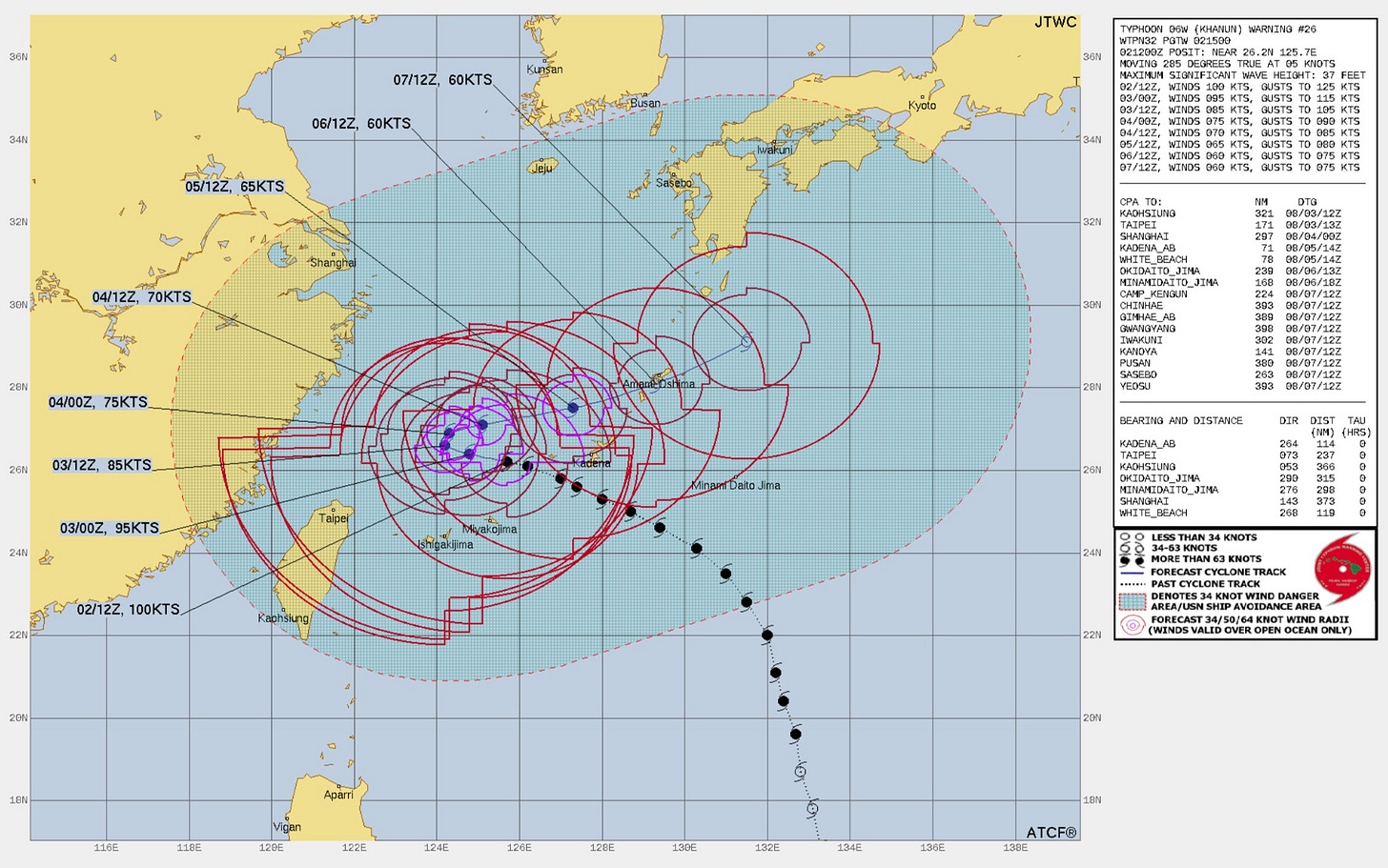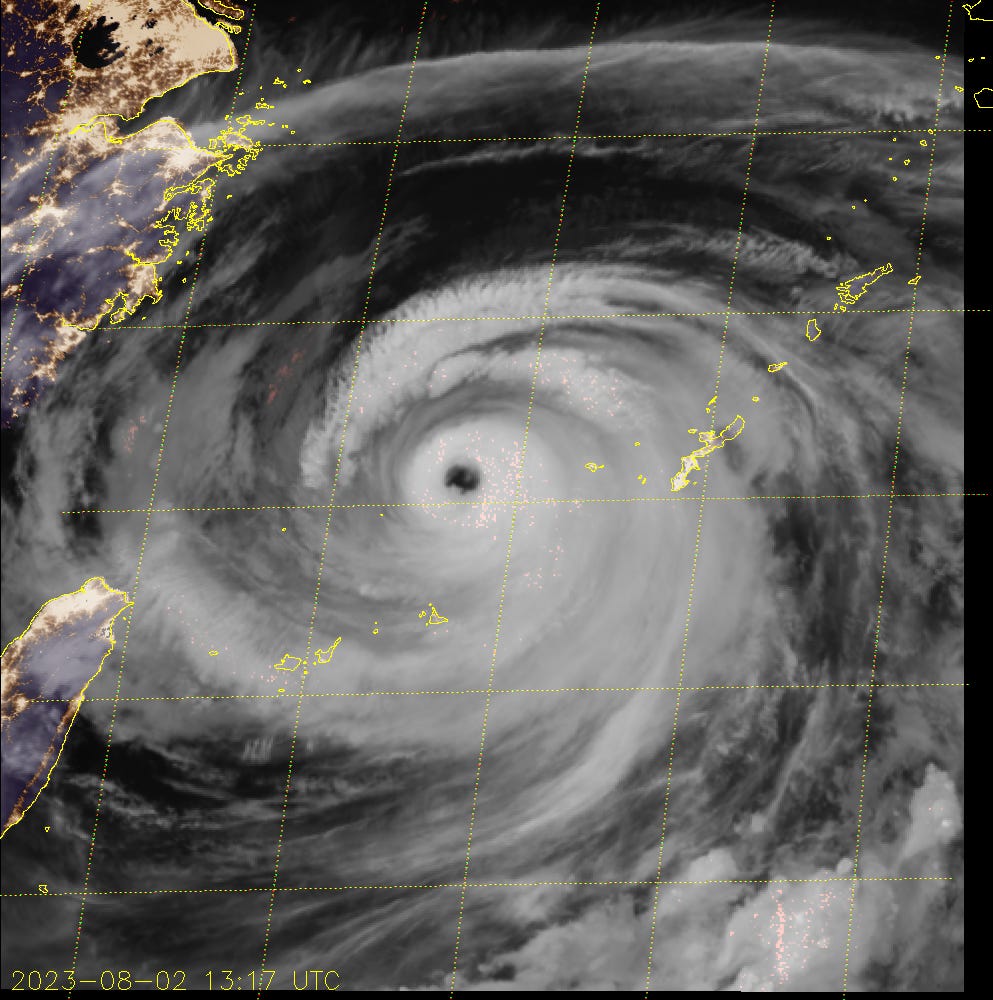Watching the Tropical Update with John Hope on the Weather Channel back in the 90s, I was fascinated when he went over to the Eastern Pacific usually right off the coast of Mexico to show a monster hurricane. The first hurricane season I remember following on a daily basis was 1995 when activity stepped up a notch with flip in Atlantic Multidecadal Variability (AMV) signal to the so-called “active era” that (maybe) continues today.
Invest 96L has been written off (10%) by the NHC in their tropical weather outlook this morning. The upper-level feature to its ENE as well as the approaching trough have created an unfavorable environment with directional wind shear. The showers and storms are disorganized. This system was honestly expected to develop and had a 70% chance (red cherry) and it did not. Interest if this is an omen for the rest of the season as El Niño kicks in.
Sea surface temperature anomaly pattern indicative of a canonical El Niño with a warm tropical Atlantic
Using a 20-year model climate instead of 30 or 1991-2020 might provide a better indication of the patterns at play. It is not clear to me what climatology period would be best or more informative or if it even matters what happened in the past 20 or 30 years to form that anomaly. It’s the actual SST that does anything, after all.
The recent typhoon activity — Doksuri and Khanun — have cooled down the western Pacific north of the Philippines and south of Japan. And, Khanun [06W] continues to slowly churn up cooler water from depth and lower the SST further with its stall tactics. It is also a rather large Typhoon with a broad wind field. This will certainly leave a huge cold wake and negative SST anomaly footprint. The coupled ECMWF HRES forecast +5 days shows a large area of 2°C cool anomaly.
JTCW forecast for Typhoon Khanun (06W) at 1500 UTC on August 2, 2023
Near-term Atlantic Activity
End of the road for Invest 96L from NHC tropical discussion 10% (2-day) and 10% (7-day)
A 1015 mb low pressure, Invest AL96, is well east-southeast of Bermuda near 28N58W, moving NW. A surface trough reaches northeastward from 26N62W through AL96 to 30N56W. Scattered moderate convection and strong SE winds continue within 240 nm of the center in the eastern semicircle. Seas in the area are 8 to 11 ft. This system has a low chance of developing into a tropical cyclone during the next 48 hours.
For paid subscribers, I will include extended range outlooks, the Eastern Pacific, and the Western Pacific typhoons using a variety of weather model and satellite analysis. Please consider signing up for additional content so I can produce more blogs on a variety of weather and climate related topics. You can even request data analysis or research or suggest worthwhile ideas.
I am currently working with Pangu-Weather and FourCastNet A.I. powered weather forecast data, and showed some examples on Twitter (@RyanMaue). I am also interested in the climatology of 90°F and 100°F across the United States — and globally! I am calculating global heat index from reanalysis from 1940-2023 to visualize the trend in apparent temperature. And finally, putting the global climate crisis of the 1870s into context of today’s transition from multiyear La Niña to El Niño.
Extended range Atlantic Tropics: Next 2-weeks
The ECMWF ensembles [August 2, 2023 00z] have become more active with a tropical wave in the central MDR developing in 7-days and then heading WNW into very favorable area of intensification.
Day 7.5 ECMWF EPS ensemble tracks (weathermodels.com)
But look at Day 12! Count on your fingers and find at least 13 hurricanes or major hurricanes out of 51 ensembles, so the wave development % is about 25%. That’s a little higher than climatology, so this bears watching in forecast model world for the next few days.
Day 12 ECMWF EPS ensemble tracks (weathermodels.com)
Note, this map is a compilation of 51-ensembles of storm tracks from the model output. The active storms at Day 12 are indicated with their tracks and the Low location along with the current minimum sea-level pressure. This does not mean there will be 4 hurricanes, but out of 51 ensembles, 4 generate a hurricane, which is < 10% chance, and that is a very weak signal.
Atlantic 2023 Year to Date
Unnamed Storm [January 2023]
Arlene 02L: 35 knots
Bret 03L: 60 knots
Cindy 04L: 50 knots
Don 05L: 65 knots
Emily is next!
Eastern Pacific Hurricane Season
Dora (05E) continues to rapidly develop well off the coast of Mexico and is moving WSW — unusual — as it will track along 10°N to 15°N avoid cold water and head into the central Pacific. That’s got some El Niño vibes. Eugene will develop in 4-5 days and parallel the Mexico coast and hopefully invigorate the SW U.S. monsoon.
Go Dora Go!
Dora is still rapidly intensifying and is well on its way to becoming a major hurricane. FORECAST POSITIONS AND MAX WINDS INIT 02/0900Z 15.8N 112.6W 80 KT 90 MPH 12H 02/1800Z 15.7N 114.6W 95 KT 110 MPH 24H 03/0600Z 15.4N 117.4W 110 KT 125 MPH 36H 03/1800Z 14.8N 120.5W 110 KT 125 MPH 48H 04/0600Z 14.4N 123.5W 100 KT 115 MPH 60H 04/1800Z 14.0N 126.8W 90 KT 105 MPH 72H 05/0600Z 13.5N 130.0W 85 KT 100 MPH 96H 06/0600Z 12.9N 136.2W 80 KT 90 MPH 120H 07/0600Z 12.7N 142.6W 75 KT 85 MPH
Eastern Pacific 2023 Year to Date
Adrian 01E: 90 knots
Beatriz 02E: 75 knots
Calvin 03E: 110 knots
Four 04E: 30 knots
Dora 05E: Forecast 110-knots [Major Hurricane]
ACE: 27 | 62% of normal (43)
Western Pacific Typhoon Season
Typhoon Khanun [06W] 100-knots | Category 3 has a large 20 nm eye with a giant 90 nm moat surrounding the tight inner core indicative of Eyewall Replacement Cycle (ERC) underway. The ERC will likely weaken the maximum sustained winds but broaden the wind field even further allowing for the upwelling of cooler water. 06W could see “rapid weakening” to tropical storm strength in a few days.
This remarkable weakening happens infrequently with weak steering currents. Not every storm has the benefit of perfect environmental circumstances. That is a statement that underpins much of the scientific nuance in the tropical cyclones and hurricanes science space. Also, the cooler water upwelled from below and warmer water forced below has a climate memory footprint. (good topic for a blog)
FORECAST DISCUSSION: TY 06W (KHANUN) IS FORECAST TO CONTINUE WEST-NORTHWESTWARD OVER THE NEXT 36 HOURS. DURING THAT TIME, AN ONGOING ERC WILL INDUCE LIMITED SHORT TERM WEAKENING THAT WILL EVENTUALLY BE EXACERBATED BY UPWELLING OF COOLER WATERS BENEATH 06W. THIS UPWELLING TAKES PLACE NEAR TAU 36, THE STR OVER THE YELLOW SEA BEGINS TO SHIFT WESTWARD AND BLOCKS ANY FURTHER MOVEMENT TOWARDS MAINLAND CHINA. AS TRACK SPEEDS GRIND TO A HALT, UPWELLING BEGINS TO QUICKLY WEAKEN THE SYSTEM. BY TAU 48, THE SYSTEM IS FORECAST TO MOVE GENERALLY EAST-NORTHEASTWARD EVENTUALLY PICKING UP SPEED WHILE CONTINUING TO WEAKEN. BEYOND TAU 72 HAS SEEN SOME OF THE GREATEST RUN TO RUN VARIABILITY, THANKS IN PART TO RIDGING, OR LACK THEREOF, TO THE NORTHEAST OF THE SYSTEM AS IT ONCE AGAIN PASSES KADENA AB. FOR THE TIME BEING, THE PREPONDERANCE OF MODEL GUIDANCE, BOTH DETERMINISTIC AND ENSEMBLE, LENDS SLIGHTLY HIGHER CREDENCE TO A PERSISTENT EAST-NORTHEASTERLY COURSE FOLLOWING TAU 72.
Western Pacific Typhoon 2023 Year to Date
Sanvu 01W: 30 knots
Mawar 02W: 160 knots
Guchol 03W: 90 knots
Talim 04W: 85 knots
Doksuri 05W: 130 knots
Khanun 06W: 115 knots + (ongoing)
ACE: 116 | 149% normal (78)












Why did my subscription payment come through as The 1908 Project?